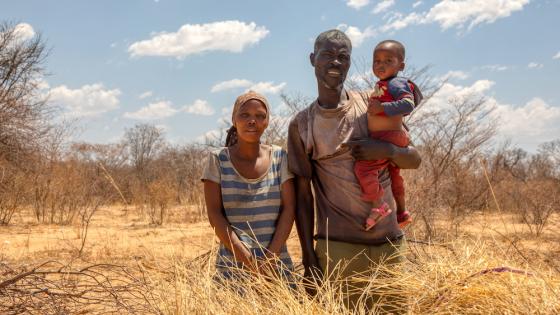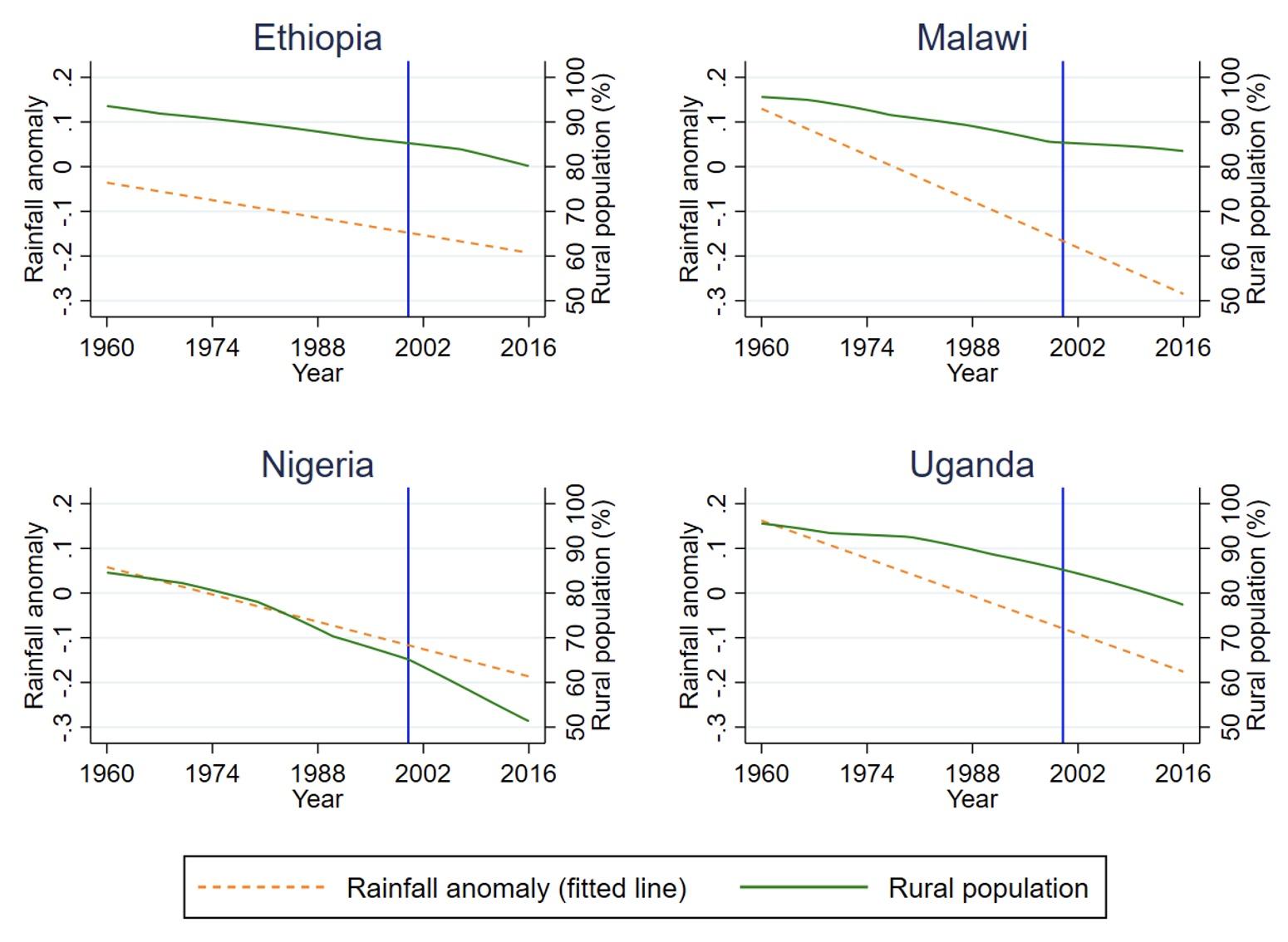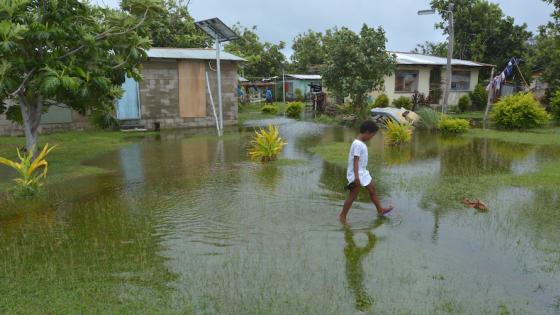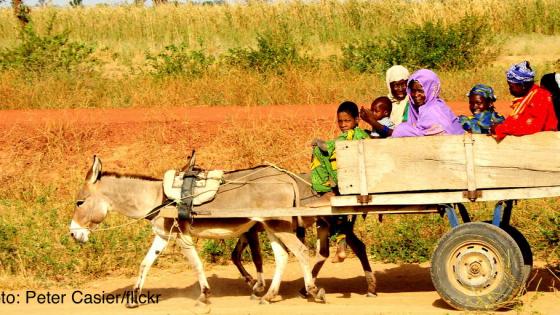The increase in extreme weather events such as droughts, floods, and other natural disasters is a distinctive aspect of the ongoing process of climate change. Many countries with the world’s lowest GDP per capita are located in sub-Saharan Africa, which is also one of the regions in the world most severely affected by the adverse impacts of climate change. The higher frequency of droughts exacerbates the economic fragility of rural agricultural areas, further undermining their development prospects (Niang et al. 2014). While migrating from rural to urban areas is a key adaptive response to these economic shocks (Peri and Robert-Nicoud 2021), existing research has so far provided mixed empirical evidence about the importance of environmental factors in affecting migration decisions (Neumann et al. 2015 Cai et al. 2016, Cattaneo and Peri 2015 and 2016, Carleton and Hsiang 2016, Mueller et al. 2020).
In a recent paper (Di Falco et al. 2022), we contribute to this literature by providing new insights on the impact of droughts on agricultural households’ migration decisions in sub-Saharan Africa, and how this varies depending on the intensity and persistence of weather shocks.
Droughts, agricultural production, and migration responses
In sub-Saharan Africa, the majority of the rural population relies on farming as its main source of income. Although agricultural practices can adapt to new climatic conditions over a longer period of time, the increased frequency and severity of droughts due to climate change significantly reduces the margins of short-term adaptation for farmers in the region (Hertel and Rosch 2011). When the climate shock is so severe, or so persistent, that falling agricultural yields fail to provide enough income for the whole household, rural-urban migration offers a way to mitigate climate stress by diversifying the income sources of the household. On the other hand, migration has substantial costs; in certain cases, if extreme weather shocks are exceptionally harmful, they can end up further constraining households’ choices, including those about migration (Cattaneo and Peri 2016, Peri and Sasahara 2019).
With climate change at the focal point of research and policy, both arguments are often mentioned in public debates. However, existing literature has so far provided mixed empirical evidence about a direct link between climate events and migration (Cattaneo et al. 2019). Most macro-level studies using lower-frequency census data find that climate shocks have a significant migration-inducing effect, potentially accelerating urbanisation, particularly for agricultural societies in sub-Saharan Africa (Marchiori et al. 2012, Barrios et al. 2006). However, within-country analyses using household data demonstrate that this impact depends on household and individual characteristics (Naudé 2010, Beine and Parsons 2015, Gray and Wise 2016).
Synthesising the advantages of the micro and macro approaches, we combine panel household surveys from the existing waves of the World Bank Living Standards Measurement Survey (LSMS) for five different countries with precipitation data by the Climatic Research Unit to construct a large rural household panel (with around 140,000 individual-wave observations). This novel dataset has the advantage of higher external validity by using multiple countries while keeping statistical robustness high thanks to a large sample size.
As seen in Figure 1, there is some suggestive evidence for a relationship between rainfall shortages and an increased pace of urbanisation in recent decades in four countries of our sample: Ethiopia, Malawi, Nigeria, and Uganda. As we can observe in the negative trend of standardised rainfall anomalies,1 a measure of drought adapted to local climate conditions, the quantity of growing-season rainfall has been decreasing since the 1960s, reflecting an increasing frequency of droughts. On the other hand, we see a steady decline in the share of rural households in the total population, indicating an urbanisation trend that is particularly advanced in Nigeria (the only middle-income country in the sample) but observable from the 1980s in Uganda and somewhat later in Ethiopia and Malawi. Especially after the year 2000 (marked by a vertical line), we see somewhat parallel trends between the reduced quantity of rain and the share of population living in rural areas. Although there are differences in the pace of the urbanisation process across countries, the similarity of the trends forecasts a potential relationship between extreme climatic events and rural-urban migration.
Figure 1 Frequency of droughts and urbanisation
Source: Authors’ calculations based on World Bank World Development Indicators (share of urban population) and CRU TS climate data.
Note: Rural population as a share of total population of the country is included directly based on the World Bank indicators. Rainfall anomaly is a standardised measure of extreme precipitation events calculated in the following way: the long-term growing-season mean rainfall is subtracted from the growing-season rainfall in a particular year, and divided by long-term standard deviation of the rainfall. Vertical line marks the year 2000.
Repeated exposure to droughts and migration decisions
To confirm the intuition shown in Figure 1, we carry out the empirical analysis by relying on a fixed effects regression methodology. First, we analyse whether individuals were more likely to migrate if a drought occurred in the year preceding the migration decision. We compare the impact of two types of droughts, both large enough to substantially disrupt agricultural production: severe droughts2 (relatively frequent, moderately harmful to crops), and extreme droughts (rare, extremely harmful to crops).
In Figure 2, we present the marginal effects of various climatic shocks – that is to say, we show the increase in the probability of migration induced by different types of droughts. As expected, migration from rural areas accelerates after both severe and extreme droughts. While the impact of droughts is moderate, extreme droughts have a twice larger migration-inducing effect (2.8%) than severe droughts (1.1%). This supports the hypothesis that the primary impact of droughts comes through the agricultural channel, such that more extreme droughts have a larger impact as agricultural adaptation becomes more difficult.
Figure 2 Marginal effect of climate shocks by severity and persistence on the probability of migration
Source: Authors’ calculations based on World Bank LSMS and CRU TS climate data.
Notes: Coefficients presented based on a fixed effects regression with the following controls: age, sex, marital status, household head or spouse, child of the household head, size of the household, post-primary education, employment, ownership of household enterprises, and the sum of all non-agricultural income. Severe droughts are defined as standardised rainfall anomalies where the wettest quarter rainfall was at least 0.5 but less than 1.5 standard deviations below the long-term mean. Extreme droughts are defined as standardised rainfall anomalies where the wettest quarter rainfall was more than 1.5 standard deviations below the long-term mean. Severe and extreme droughts of one to five years are calculated as the sum of occurrences of severe and extreme droughts for the past one to five years respectively. Further details available for the others.
In a second step, we estimate the impact of droughts that happened several years before the migration decision was made. We argue that if rainfall shortages gradually erode households’ adaptation capabilities, which is the case when they repeatedly destroy crops, then the droughts’ impact is likely to persist for more than one year, and migration from rural to urban areas can remain high for several years after the droughts occurred. To test this hypothesis, we compare the impact of a drought that the household experienced in the past year (first line of the two subfigures on Figure 2), with the impact of a drought that the household experienced at any point in the past two to five years (second to fifth line of the two subfigures on Figure 2).
On the one hand, severe and extreme droughts have a long-lasting impact, increasing migration for at least five years after they occur. Moreover, this impact does not significantly fade or diminish over time. The average impact of experiencing an additional severe or extreme drought any time in the past five years (0.7% and 1.8%, respectively) is comparable in magnitude to the impact of experiencing a severe or extreme drought in the previous year (1.1% and 2.8%, respectively). All severe and extreme droughts that households experienced in the past five years have an impact on the contemporaneous probability of migration, resulting in a much higher number of migrants than we would expect based on the effect of last year’s droughts alone. This means that while a single drought has a relatively moderate migration-inducing effect, a series of severe shocks have a much larger effect, ranging from 0.7% (experiencing one severe drought) to 9% (experiencing five extreme droughts).
To give a sense of the magnitude of this impact, consider the scenario if the combined population of the five countries in our sample experienced one severe and three extreme droughts during five consecutive years. In this case, the combined cumulative impact over multiple years would amount to five times the yearly impact, reaching altogether up to 1.1 million additional rural out-migrants in the five countries.
This result complements existing evidence from studies on natural disasters in Mexico and Southeast Asia (Bohra-Mishra et al. 2014, Sedova and Kalkuhl 2020, Saldana-Zorrilla and Sandberg 2009). Our study shows the importance of incorporating the impact of cumulative past weather shocks, rather than only recent single events, in the empirical investigation of migration decisions.
Concluding remarks
By using a novel dataset based on five sub-Saharan African countries, we show that focusing only on the effect of weather shocks in the short-term may lead to an underestimation of the impact of climate change on rural-urban migration. Our results point to the importance of examining the cumulative impact of climate change and other shocks over time in order to advance our understanding of the determinants of migratory flows, their impact on individuals themselves and on the sending and receiving regions. In a context where a plethora of climatic models forecast an increase in the frequency of extreme events in Africa, the burden of climate change and its cumulative effects on vulnerable agricultural populations in low-income countries has to be addressed in global climate change policies.
References
Barrios, S, L Bertinelli and E Strobl (2006), “Climatic Change and Rural-Urban Migration: The Case of Sub-Saharan Africa”, Journal of Urban Economics 60: 357–371.
Bohra-Mishra, P, M Oppenheimer and S M Hsiang (2014), “Nonlinear permanent migration response to climatic variations but minimal response to disasters”, PNAS 111(27).
Cai R, S Feng, M Oppenheimer and M Pytlikova (2016),” Climate variability and international migration: The importance of the agricultural linkage”, Journal of Environmental Economics and Management 79: 135–151.
Carleton, T A and S M Hsiang (2016), “Social and economic impacts of climate”, Science 353(6304).
Cattaneo, C and G Peri (2015), “Migration’s response to increasing temperatures”, VoxEU.org, 14 November.
Cattaneo, C and G Peri (2016), “The migration response to increasing temperatures”, Journal of Development Economics 122: 127–146.
Cattaneo, C, M Beine, C J Fröhlich, D Kniveton, I Martinez-Zarzoso, M Mastrorillo and B Schraven (2019), “Human migration in the era of climate change”, Review of Environmental Economics and Policy 13(2): 189–206.
Di Falco, S, A B Kis and M Viarengo (2022), “Climate Anomalies, Natural Disasters and Migratory Flows: New Evidence from Sub-Saharan Africa”, IZA Discussion Paper No. 15084 and IHEID Center for International Environmental Studies Working Paper No. 73/2022.
Gray, C and E Wise (2016), “Country-specific effects of climate variability on human migration”, Climatic Change 135: 555–568.
Henderson, J V, A Storeygard and U Deichmann (2016), “Has climate change driven urbanization in Africa?”, Working Paper.
Hertel, T and S Rosch (2011), “Climate change and agriculture: Implications for the world’s poor” VoxEU.org, 17 March.
Mueller, V, G Sheriff, X Dou and C Gray (2020), “Temporary migration and climate variation in eastern Africa”, World Development (2020), 126: 104704.
Naudé, W (2010), “The Determinants of Migration from Sub-Saharan African Countries”, Journal of African Economies 19(3): 330¬–356.
Neumann, K, D Sietz, H Hilderink, P Janssen, M Kok and H van Dijk (2015), “Environmental drivers of human migration in drylands – a spatial picture”, Applied Geography 56: 116–26.
Niang, I, O C Ruppel, M A Abdrabo, A Essel, C Lennard, J Padgham and P Urquhart (2014), “Africa”, in Climate Change 2014: Impacts, Adaptation, and Vulnerability, Part B: Regional Aspects, Cambridge University Press, 1199–1265.
Peri, G and A Sasahara (2019), “The effects of global warming on rural–urban migrations”, VoxEU.org, 15 July.
Peri, G and F Robert-Nicoud (2021), “On the economic geography of climate change”, VoxEU.org, 11 October.
Sedova, B and M Kalkuhl (2020), “Who are the climate migrants and where do they go? Evidence from rural India”, World Development 129, 104848.
Saldana-Zorrilla, S and K Sandberg (2009), “Spatial econometric model of natural disaster impacts on human migration in vulnerable regions of Mexico”, Disasters 33:591–607.
Endnotes
1 Rainfall anomaly is a standardised measure of extreme precipitation events calculated in the following way: the long-term growing-season mean rainfall is subtracted from the growing-season rainfall in a particular year, and divided by long-term standard deviation of the rainfall.
2 Severe droughts are defined as standardised rainfall anomalies where the wettest quarter rainfall was at least 0.5, but less than 1.5 standard deviations below the long-term mean. Extreme droughts are defined as standardised rainfall anomalies where the wettest quarter rainfall was more than 1.5 standard deviations below the long-term mean.








